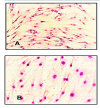In vitro biocompatibility testing of some synthetic polymers used for the achievement of nervous conduits
- PMID: 22567047
- PMCID: PMC3168829
In vitro biocompatibility testing of some synthetic polymers used for the achievement of nervous conduits
Abstract
Biocompatible synthetic polymers are largely used in the bio-medical domain, tissue engineering and in controlled release of medicines. Polymers can be used in the achievement of cardiac and vascular devices, mammary implants, eye lenses, surgical threads, nervous conduits, adhesives, blood substitutes, etc. Our study was axed on the development of cytotoxicity tests for 3 synthetic polymers, namely polyvinyl alcohol, polyethylene glycol and polyvinyl chloride. These tests targeted to determine the viability and morphology of cells (fibroblasts) that were in indirect contact with the studied polymers. Cell viability achieved for all the studied synthetic polymers allowed their frame in biocompatible material category. Cell morphology did not significantly change, thus accomplishing a new biocompatibility criterion. The degree of biocompatibility of the studied polymers varied. Polyvinyl alcohol presented the highest grade of biocompatibility and polyvinyl chloride placed itself at the lowest limit of biocompatibility. The results achieved allowed the selection of those polymers that (by enhancing their degrees of biocompatibility due to the association with various biopolymers) will be used in the development of new biocompatible materials, useful in nervous conduits manufacture.
Keywords: MTT test; Polyvinyl alcohol; dermal fibroblasts; polyethylenglycol; polyvinyl chloride.
Figures






References
-
- Rimell J. Selectiv Laser Sintering of Ultra High Molecular Weight Polyethilene for chemical Application . J Biomed Mater Res . 2000;53:414–420. - PubMed
-
- Pizzoferrato AG. Cellular events in the mechanisms of prosthesis loosening . Clin Mater. 1991;7:51–81. - PubMed
-
- Peluso G. Macrophage activation induced by different carbon fiber–epoxy resin composites . J Biomed Mat Res. 1991;25:637–649. - PubMed
-
- Chiellini E. Biomedical Polymers and Polymers Therapeutics . New York: Kluwer Academie, Plenum Publishiers; 2001.
-
- Bouet T. Quantitative in vivo studies of hyperemia in the course of the tissue response to biomaterial implantation . J Biomed Mat Res. 1990;24:1439–1461. - PubMed
MeSH terms
Substances
LinkOut - more resources
Full Text Sources
Other Literature Sources
